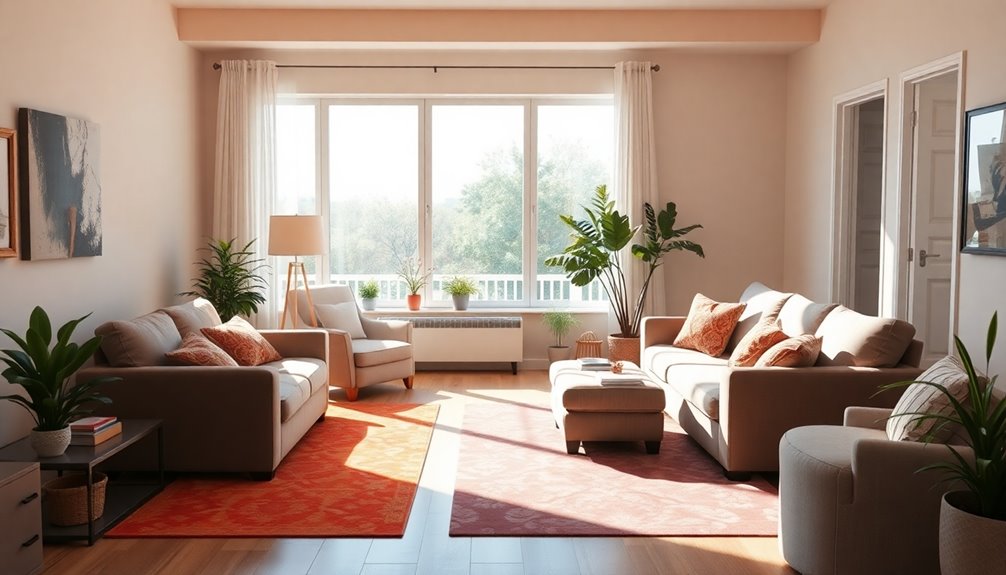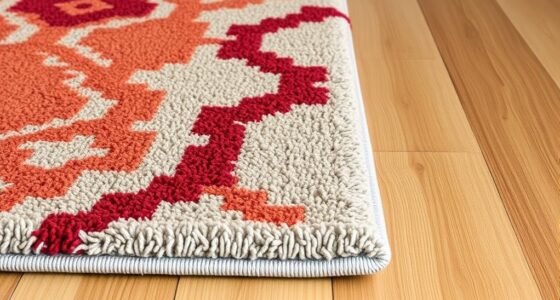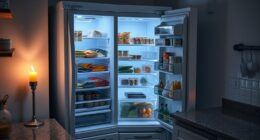If you’re looking to transform your home layout with senior-friendly designs, focus on universal design principles that enhance safety and comfort. Create accessible entryways with wider doorways and slip-resistant flooring. Install proper motion-sensor lighting and add convenient landing places for ease of movement. Don’t forget to adapt bathrooms with grab bars and non-slip surfaces. By revitalizing your decor and personalizing your space, you can promote connection and well-being. Let’s explore more ideas to make your home inviting and secure! Consider incorporating furniture with rounded edges to reduce the risk of injury and selecting sturdy chairs and tables that offer enough support. Additionally, integrating smart home technology can enhance convenience, making it easier to control lighting and temperature with just a voice command. By implementing these revamp your living space tips, you’ll not only create a safer environment but also foster a nurturing and appealing atmosphere for all ages. Furthermore, consider adding contrasting colors to walls and furniture to help individuals with vision impairments navigate their space more easily. Plants and greenery can also be incorporated to bring life into your home while improving air quality. By focusing on these elements, you can truly revitalize your home design and create a welcoming environment that prioritizes safety and comfort for everyone.
Key Takeaways
- Widen doorways to at least 36 inches to accommodate wheelchair access and mobility aids for easier navigation throughout the home.
- Incorporate slip-resistant flooring and minimal thresholds to reduce fall risks and create seamless transitions between rooms.
- Install grab bars in bathrooms and near toilets for essential support, ensuring they are securely anchored for safety.
- Utilize layered lighting with motion-sensor fixtures in high-traffic areas to enhance visibility and reduce the risk of accidents.
- Arrange furniture to create clear pathways, promoting stability and ease of movement for seniors and caregivers alike.
Understanding the Principles of Universal Design for Home Modifications

When you think about home modifications, understanding the principles of universal design can make a significant difference in creating spaces that are accessible for everyone.
These universal design principles focus on enhancing accessibility, safety, and comfort for individuals of all ages and abilities. Key elements include equitable use, ensuring everyone benefits, and flexibility in use, accommodating various preferences.
By incorporating features like wider doorways and lever-style handles, you can reduce the risk of falls, promoting an aging-in-place design. This thoughtful approach not only enhances your quality of life but also fosters an inclusive living environment for caregivers, children, and visitors. Additionally, implementing these design elements can increase your home's market value, appealing to potential buyers seeking accessibility. Strong communication skills are essential for effectively collaborating with contractors and designers to ensure your vision is realized.
Creating Safe and Accessible Entryways for the Elderly
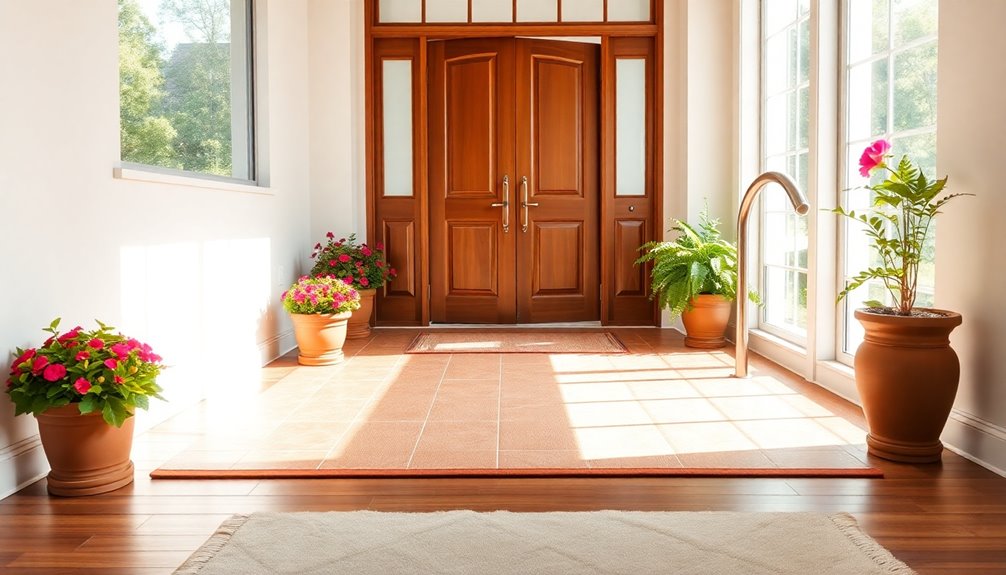
How can you guarantee that your entryway is safe and accessible for elderly residents?
Start by ensuring you have wider doorways, at least 36 inches, to accommodate mobility aids like wheelchairs and walkers. Incorporate slip-resistant flooring to minimize the risk of falls, along with minimal thresholds to prevent tripping hazards.
Adding convenient landing places, like small tables or benches, allows residents to securely place items when entering or exiting. Enhance visibility with proper lighting, including bright, glare-free fixtures and motion-sensor lights that activate as they approach.
Finally, use contrasting colors for door frames and flooring to create visual differentiation, aiding navigation for those with visual impairments.
These safety features will make a significant difference in their daily lives.
Installing Proper Lighting
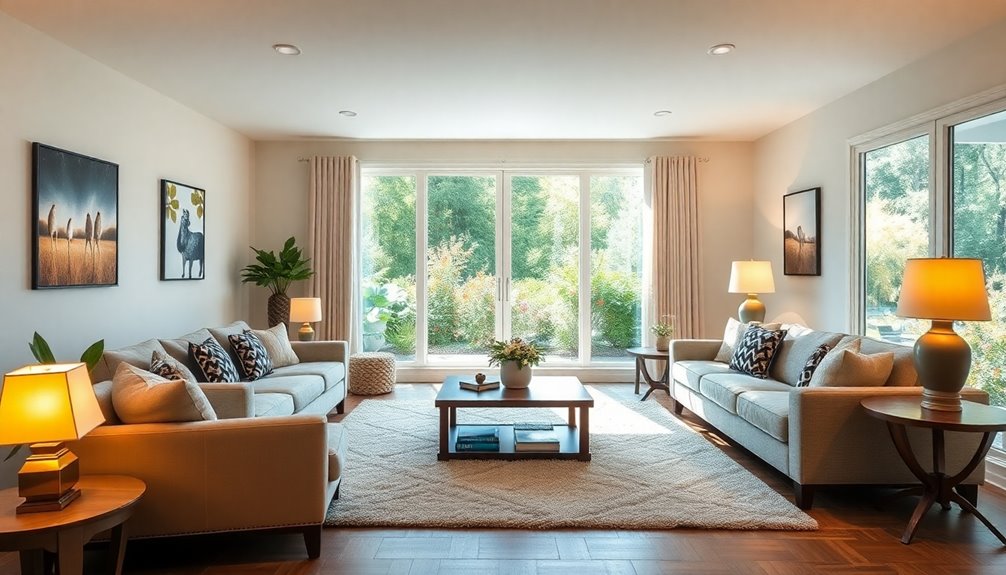
Proper lighting is essential for creating a safe home environment for seniors. It reduces the risk of falls and accidents, making navigation easier.
Here are some key considerations for effective lighting:
- Use bright, glare-free fixtures to illuminate entryways and high-traffic areas.
- Incorporate motion-sensor lights that activate automatically when someone approaches, enhancing safety.
- Install lighting along walkways and stairways for better visibility and to clearly mark boundaries.
- Ensure house numbers are well-lit to assist emergency responders in locating your home quickly.
- Adopt a thorough lighting strategy that includes ambient, task, and accent lighting for overall home safety.
Additionally, using air purifiers can further improve indoor air quality, making the environment healthier for seniors.
Adding Convenient Landing Places
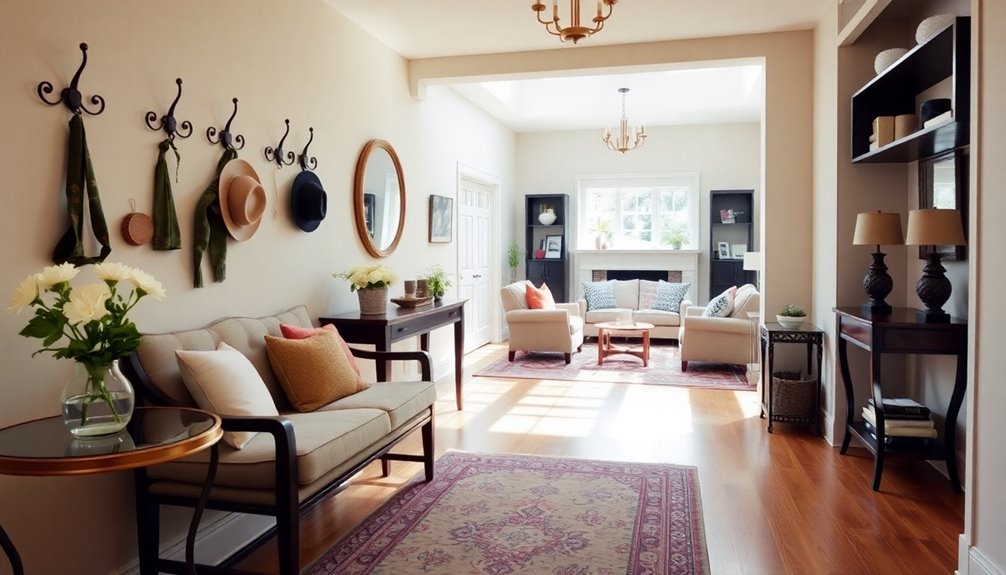
Creating a safe and functional home for seniors can be as simple as adding a few convenient landing places. By incorporating small tables or benches near entryways, you enhance convenience and create secure surfaces for placing items when entering or exiting your home.
These thoughtful designs greatly reduce the risk of dropping items or losing balance, making them particularly beneficial for those with mobility challenges. Strategically positioned landing spots facilitate smoother shifts from outside to inside, allowing you to manage your belongings more effectively.
Plus, these areas can serve as resting spots, helping seniors navigate their homes without feeling rushed or overwhelmed. Verify the height and stability of these landing places accommodate various mobility needs for an accessible and functional space. Additionally, consider non-toxic large houseplants to enhance the environment while ensuring safety for pets.
Enhancing Mobility Throughout the Home

To guarantee seniors can move around their homes with confidence, enhancing mobility is essential. Here are some effective strategies to take into account:
- Upgrade to lever-style door handles for easier mobility.
- Install slip-resistant flooring to minimize trip hazards, reducing the risk of falls.
- Widen doorways to at least 36 inches for wheelchair access and smoother navigation.
- Reduce thresholds between rooms for seamless shifts across different flooring types.
- Arrange furniture to create clear pathways, providing stability for those who may need to lean while moving.
Additionally, confirm that light quality is adequate throughout the space to improve visibility.
Designing Elder-Friendly Staircases
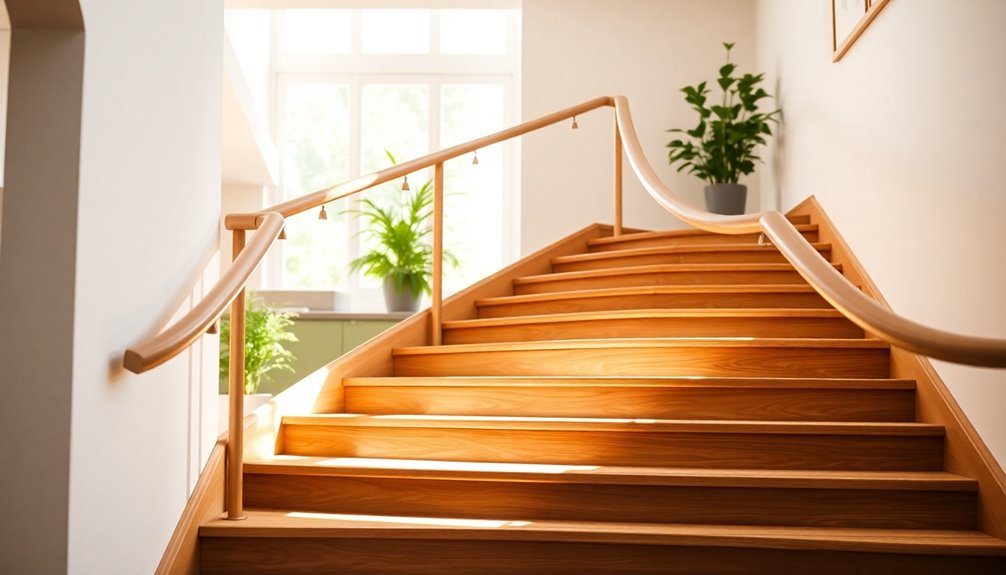
Staircases can pose considerable challenges for seniors, but thoughtful design can make them safer and more accessible.
Installing handrails on both sides provides essential support, markedly enhancing safety and fall prevention. Verify these handrails are securely anchored, easy to grip, and extend beyond the top and bottom steps for added security.
Adequate lighting is vital; consider overhanging lights or motion-sensor options to improve visibility, and use contrasting colors for handrails.
Additionally, choose non-slip materials for stair treads to minimize slipping risks, and LED strip lights along step edges can further enhance visibility.
Regular maintenance—like repairing loose steps and keeping pathways clear—helps you maintain a safe environment for older adults traversing your home.
Adapting Bathrooms for Increased Safety for the Elderly

When adapting bathrooms for safety, you'll want to focus on essential grab bar placement and non-slip flooring options.
Installing grab bars near toilets and in showers can provide vital support and prevent falls.
Choosing non-slip materials will help create a safer environment, especially on wet surfaces.
Essential Grab Bar Placement
Creating a safe bathroom environment for seniors hinges on the strategic placement of grab bars. Properly positioned, these bars can greatly enhance stability and guarantee safety during daily activities.
Here are some essential placement tips:
- Install grab bars near the toilet, 33 to 36 inches above the floor.
- Place horizontal grab bars in the shower at 33 to 36 inches and vertical ones at the entry.
- Add grab bars by the bathtub, 18 inches above the rim, extending horizontally.
- Confirm all grab bars are securely anchored to wall studs to support at least 250 pounds.
- Assess grab bar placement based on individual needs for maximum effectiveness. Additionally, integrating natural elements like wood and stone can create a more comforting and visually appealing bathroom atmosphere for seniors.
Non-Slip Flooring Options
To enhance safety in bathrooms for seniors, choosing the right non-slip flooring is vital. Non-slip flooring materials like textured vinyl, rubber, and treated tile greatly reduce the risk of slips and falls, which are common dangers for older adults.
Opting for flooring with a coefficient of friction (COF) rating of at least 0.6 guarantees adequate slip resistance, especially in wet areas. Installing non-slip surfaces can decrease accidents by up to 80%, making it a key feature in aging-in-place designs.
You can further improve grip with additional treatments or textured finishes without sacrificing aesthetics. Remember, regular maintenance, including cleaning and reapplying treatments, is essential to keep your non-slip flooring effective and maintain safety for elderly residents.
Optimizing Lighting for Aging Eyes
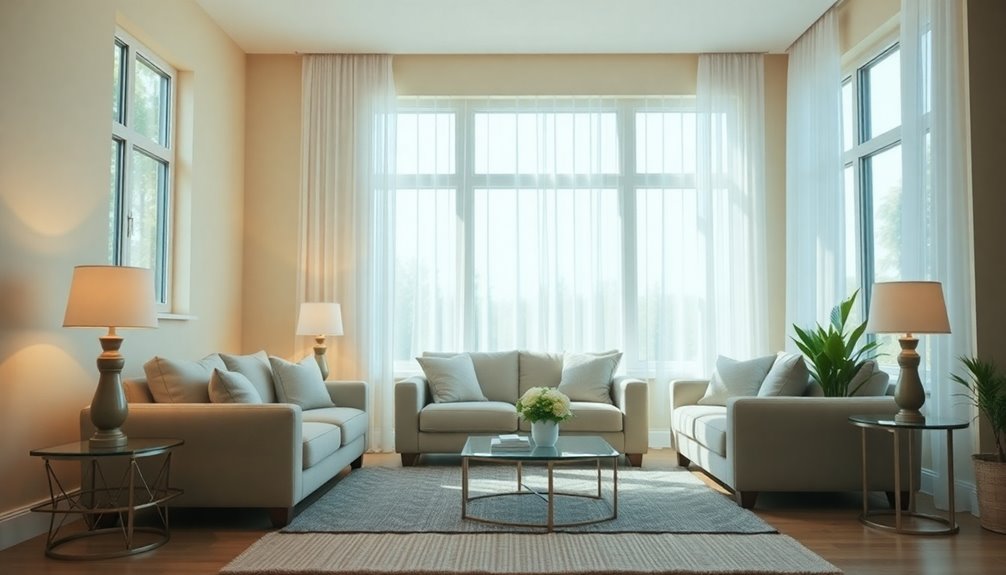
As you age, your eyes need more light to see clearly, so increasing brightness in your home is essential.
Task lighting can make activities like reading or cooking easier and safer, allowing you to focus on what you're doing. Additionally, optimizing lighting can enhance energy efficiency in your home, which is crucial for reducing costs as you age.
Increased Brightness Needs
Since aging often brings changes in vision, optimizing lighting becomes essential for maintaining safety and independence at home.
To address increased brightness needs, consider the following strategies:
- Illuminate high-traffic areas with bright, even lighting to reduce the risk of injury.
- Use natural light whenever possible to enhance mood and visibility.
- Install light fixtures that minimize glare, like matte or frosted finishes.
- Incorporate ambient and task lighting in key rooms, such as kitchens and bathrooms, to improve daily activities.
- Aim for up to twice the amount of light in living spaces to support overall quality of life. Additionally, be mindful of sun protection to safeguard skin from UV exposure while enjoying natural light indoors or outdoors.
Task Lighting Importance
While many aspects of home design cater to comfort, task lighting is essential for older adults, providing the focused illumination necessary for daily activities.
It greatly enhances visibility and reduces eye strain, making tasks like reading or cooking easier. Strategic placement of light sources in high-traffic areas can help prevent accidents by illuminating potential hazards.
Consider adjustable task lighting to customize brightness levels, which is vital as visual acuity declines with age. LED bulbs are a great choice for task lighting, offering bright, energy-efficient illumination that lasts longer and produces less heat.
Implementing effective task lighting strategies, such as under-cabinet lights in kitchens, will promote independence and comfort in your home environment, making daily activities safer and more enjoyable. Additionally, maintaining a clean home can further enhance safety by minimizing clutter that obstructs pathways and increases the risk of falls.
Refreshing Your Space With Thoughtful Decor
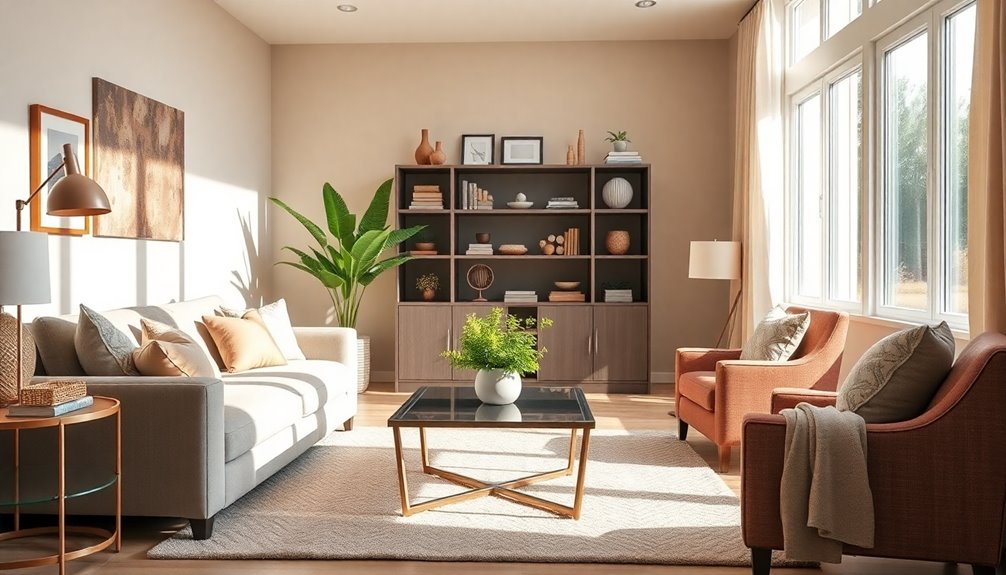
Revitalizing your space with thoughtful decor can considerably enhance your home's comfort and aesthetic, especially for seniors.
By focusing on a few key elements, you can create a welcoming environment that promotes relaxation and well-being:
- Choose soft, muted tones like blues and greens for a calming atmosphere.
- Invest in comfortable seating with lumbar support and padded armrests for better posture.
- Utilize layered lighting—ambient, task, and accent—to improve visibility and reduce accidents.
- Incorporate indoor plants to enhance decor and improve air quality.
- Display personal memorabilia and family photos to foster a sense of belonging.
Additionally, the incorporation of natural elements can promote tranquility and enhance the overall ambiance of your space.
These thoughtful additions not only beautify your home but also contribute to a healthier and more comfortable living space.
Personalizing Your Home for Comfort and Connection
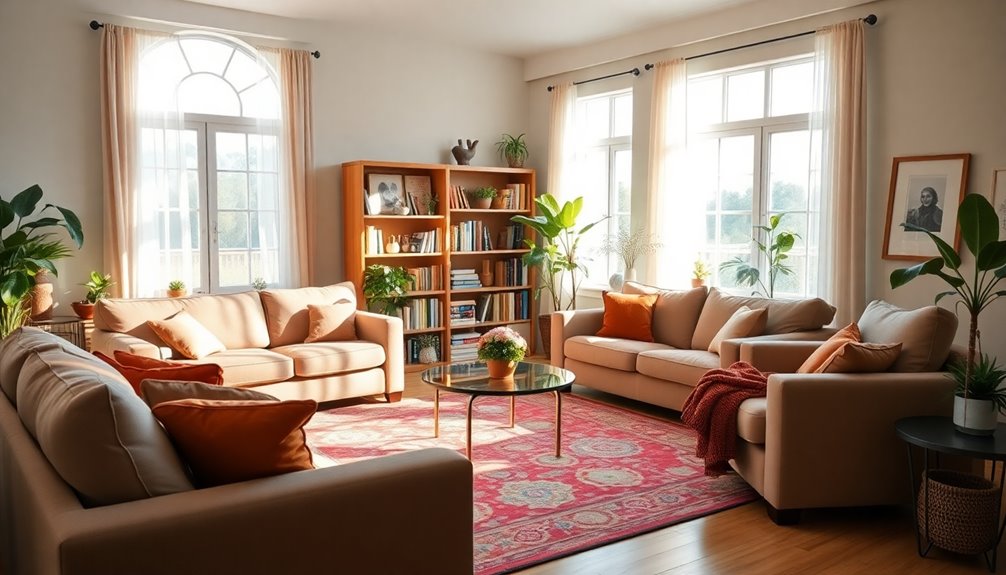
Creating a home that reflects your personality and experiences can greatly enhance your comfort and connection to the space, especially for seniors. Personalizing your home with items that showcase your hobbies and cultural background fosters emotional well-being, making you feel more at ease.
Incorporating family photos and memorabilia not only strengthens family ties but also sparks cherished memories, boosting your mental health. Choose a balanced color palette with soft tones to create a calming atmosphere that reduces stress.
Adding a dedicated memory wall highlights your achievements and life journey, enhancing self-esteem. Finally, selecting multi-functional furniture that meets mobility needs while reflecting your style helps maintain your independence and comfort in everyday living. Additionally, consider implementing a retirement savings plan to ensure financial security that allows you to enjoy your personalized space fully.
Frequently Asked Questions
How Can I Make My House Elderly Friendly?
To make your house elderly friendly, start by widening doorways to at least 36 inches for easy wheelchair access.
Install slip-resistant flooring to prevent falls and enhance safety.
Add grab bars in bathrooms and staircases for stability.
Improve lighting with bright, glare-free fixtures and motion sensors.
Finally, choose lever-style door handles and easy-to-grasp cabinet hardware to reduce strain.
These adjustments will create a safer and more accessible environment for seniors.
How to Design a House for Seniors?
Designing a house for seniors is like crafting a cozy nest that nurtures comfort and safety.
Start by widening doorways to at least 36 inches, ensuring smooth wheelchair access. Opt for slip-resistant flooring to reduce fall risks, especially in high-traffic areas.
Incorporate single-level living or ramps, and create bathrooms with no-threshold showers and grab bars.
Finally, utilize ergonomic features like lever-style door handles to make everyday tasks easier and more accessible.
What Is the Most Desirable Home Design for Aging in Place?
The most desirable home design for aging in place focuses on accessibility and safety.
You'll want an open floor plan that allows easy navigation, with wider doorways and hallways. Incorporating universal design elements, like lever-style door handles and non-slip flooring, makes daily tasks easier.
Additionally, adding grab bars in bathrooms and proper lighting will enhance security. Adjustable countertops and accessible storage solutions will further improve functionality, ensuring your home meets your needs as you age.
How to Design for Elderly People?
When designing for elderly people, focus on creating a safe and accessible environment.
You can widen doorways to at least 36 inches for easy navigation with mobility aids. Choose slip-resistant flooring and minimize thresholds to prevent falls.
Make sure lighting controls are within easy reach and consider motion-sensor lights for better visibility.
In bathrooms, install grab bars and no-threshold showers to enhance comfort and safety.
These thoughtful changes can greatly improve their quality of life.
Conclusion
By embracing these senior-friendly designs, you're not just transforming your home; you're creating a haven of comfort and safety. Coincidentally, as you enhance your space for loved ones, you often find it enriches your own life too. When you prioritize accessibility, you foster connections that deepen relationships and make everyday moments more enjoyable. So go ahead, make these changes, and watch how your home evolves into a welcoming sanctuary for everyone, including yourself.
